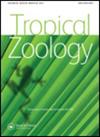A spider that decorates its web perpendicular to the web plane
IF 0.4
4区 生物学
Q4 ZOOLOGY
引用次数: 1
Abstract
This paper examines and describes web decorating behavior by juveniles of the orb-weaving spider, Trichonephila antipodiana. Decorations consist of a three-dimensional ‘tube’ of silk line scaffolding within which detritus, prey items and moult exuviae are laid perpendicular to the web plane, extending from the central sticky web forward and backward to the dorsal and ventral barrier webs. Complementarity with barrier web construction, combined with the vulnerability of this ontogenetic stage, suggest that the primary function of the decorations is as an anti-predator device. Various lines of evidence support the view that the fundamental structural purpose of the decorations is perpendicular extension: (1) median web residency time was significantly greater for juveniles with decorations ≥ 1 cm in size; (2) detritus was the primary contributor to decoration length; and (3) examination of the in-laying technique for prey inclusions found them to be ‘unnecessarily’ dismembered and stretched out along the decorative plane. Although there is probably some degree of interdependence between predator avoidance and prey catching success, extension as a property fits most consistently within a defensive interpretation of function in so far as it confers either distance from and/or interference with predators.垂直于网平面装饰其网的蜘蛛
本文研究并描述了圆织蜘蛛Trichonephila antipodiana幼蛛的织网行为。装饰包括一个三维的“管”,由丝线脚手架组成,其中碎屑、猎物和蜕皮物垂直于网面,从中央粘网向前和向后延伸到背侧和腹侧的屏障网。与屏障网结构的互补性,结合这一个体发生阶段的脆弱性,表明装饰的主要功能是作为一种防捕食者的装置。各种证据都支持这样的观点,即装饰的基本结构目的是垂直延伸:(1)尺寸≥1 cm的装饰显著增加了幼鱼的网驻留时间中位数;(2)碎屑是影响装饰长度的主要因素;(3)对猎物内含物的嵌入技术的检查发现,它们被“不必要地”肢解并沿着装饰平面伸展。尽管在躲避捕食者和成功捕获猎物之间可能存在某种程度的相互依赖关系,但伸展作为一种属性,就其赋予与捕食者的距离和/或干扰而言,最符合对功能的防御解释。
本文章由计算机程序翻译,如有差异,请以英文原文为准。
求助全文
约1分钟内获得全文
求助全文
来源期刊

Tropical Zoology
生物-动物学
CiteScore
2.50
自引率
0.00%
发文量
1
审稿时长
>12 weeks
期刊介绍:
Tropical Zoology is an international zoological journal publishing original papers in the field of systematics, biogeography, phylogeny, ecology and conservation of all terrestrial and aquatic animal Phyla from tropical and subtropical areas.
Only papers with new information, high quality and broad interest are considered. Single species description and checklists are not normally accepted. Review papers are welcome. The journal is owned by the Istituto di Ricerca sugli Ecosistemi Terrestri of the Consiglio Nazionale delle Ricerche, Florence, Italy (CNR-IRET) who performs research into the structure and functioning of aquatic and terrestrial ecosystems, focusing in particular on anthropogenic pressure and global change. The knowledge amassed forms the scientific basis for identifying the most appropriate protective and corrective interventions, and provides support for the bodies entrusted with formulating policies for environmental protection and recovery.
 求助内容:
求助内容: 应助结果提醒方式:
应助结果提醒方式:


